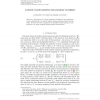2996 search results - page 7 / 600 » Numberings and Randomness |
CHES
2003
Springer
14 years 3 months ago
2003
Springer
A true random number generator (TRNG) usually consists of two components: an “unpredictable” source with high entropy, and a randomness extractor — a function which, when app...
MOC
2000
13 years 9 months ago
2000
We improve on a lattice algorithm of Tezuka for the computation of the k-distribution of a class of random number generators based on finite fields. We show how this is applied to ...
STOC
2004
ACM
14 years 10 months ago
2004
ACM
Given d (0, ) let kd be the smallest integer k such that d < 2k log k. We prove that the chromatic number of a random graph G(n, d/n) is either kd or kd + 1 almost surely.
APPROX
2004
Springer
14 years 3 months ago
2004
Springer
Given any integer d ≥ 3, let k be the smallest integer such that d < 2k log k. We prove that with high probability the chromatic number of a random d-regular graph is k, k + 1...
FPGA
2008
ACM
13 years 11 months ago
2008
ACM
This paper introduces a method of constructing random number generators from four of the basic primitives provided by FPGAs: Flip-Flips, Lookup-Tables, Shift Registers, and RAMs. ...

